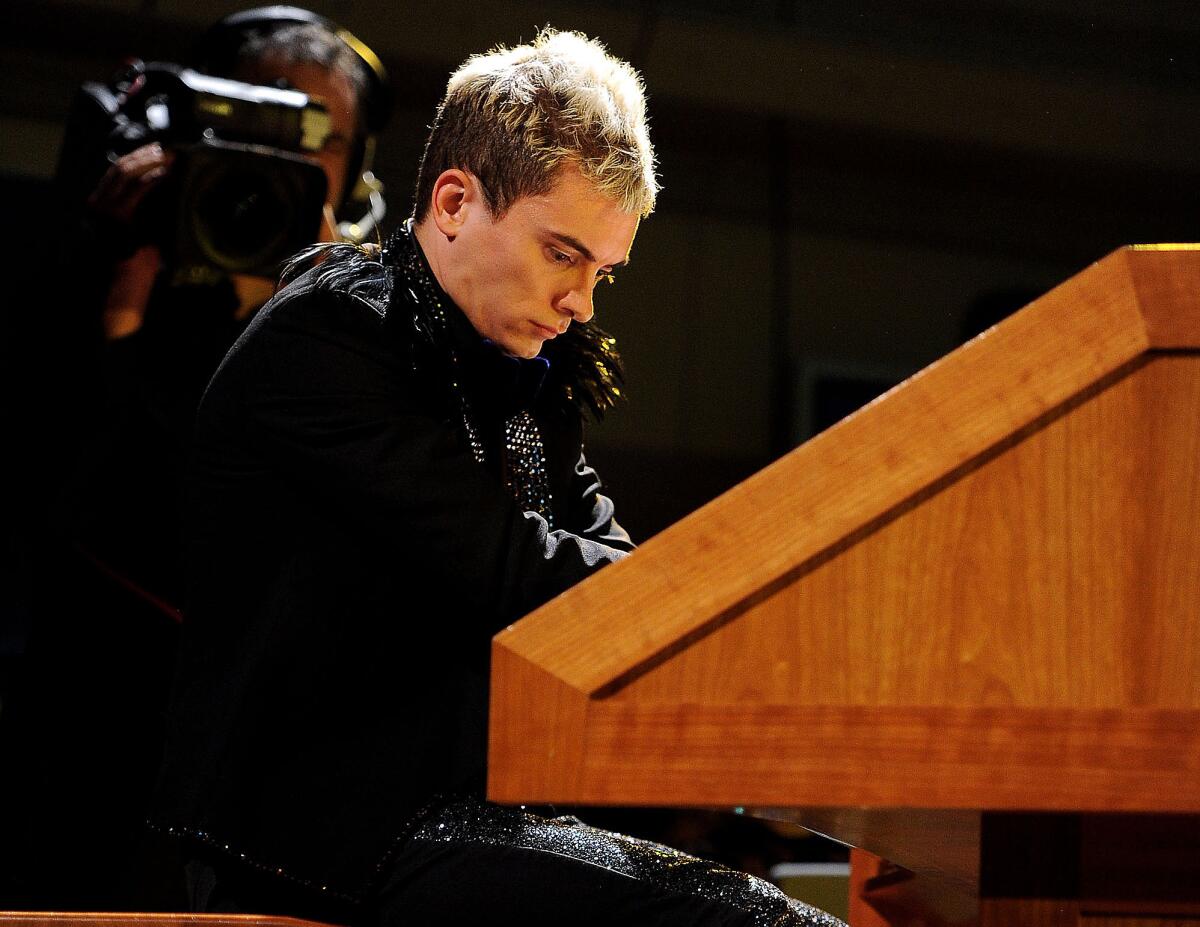Review: Minimalist Jukebox Festival anything but minimal here

The Los Angeles Philharmonic’s Minimalist Jukebox Festival orchestral program last weekend was not minimal, which Roget’s tells us is synonymous for negligible, trifling, slight, nominal, token, insignificant, smallest. Find a dictionary of antonyms and you’ll have a better idea of what it means when Hurricane Mama bellows, as she does every few years when Terry Riley blows into town.
This meteoro-musicological phenomenon was first felt six years ago in Walt Disney Concert Hall when Riley played the organ, which he dubbed Hurricane Mama. The composer of “In C,” the 1964 work that inspired the Minimalist movement, has a psychedelic imagination, and he all but blasted the roof off Frank Gehry’s building and set its steel a shimmer.
Riley’s “At the Royal Majestic,” an organ concerto written for Cameron Carpenter as soloist and given its world premiere Friday night in Disney, is the most ambitious L.A. Phil commission of the festival. John Adams, the Minimalist Jukebox curator, conducted on a program that included his epic symphony, “Naïve and Sentimental Music,” premiered by the L.A. Phil in 1999. The daring program began with the U.S. premiere of Michael Gordon’s “Sunshine of Your Love,” also from 1999 and what is surely the loudest sustained noise a conventional symphony orchestra has ever been asked to make and a conventional symphony orchestra subscription audience has ever been asked to accept.
PHOTOS: Best classical concerts of 2013 | Mark Swed
Each piece required an immense, eccentrically configured orchestra. Gordon, for instance, required four ensembles, with each tuned a fraction of a pitch off from the others. Riley went in for a massive wind section, including no fewer than six flutes and six bassoons, as adjuncts to the organ pipes. The stage set up in the first half between the Gordon and Riley concert took a dozen efficient stagehands 20 minutes.
This was, in other words, a program of monumental Minimalism, to say nothing of majestic Minimalism.
The first movement of Riley’s concerto, titled “Negro Hall’ and lasting more than half the length of the full 37-minute score, is based on music he wrote for a chamber opera about the Swiss outsider artist Adolf Wölfli, who imagined New York’s dance scene in the early 20th century without having ever having left Switzerland. Riley then imagined what Wölfli might have imagined. The result is a movement that teems with variety, from gospel organ to psychedelic jitterbug to a waltz that might have come from a Jeanette MacDonald movie.
In the second movement, “The Lizard Tower Gang,” slow ragtime and organ blues, like you’ve never heard before, emerge out of a chattering orchestra. The finale, “Circling Kailash,” builds into a glorious organ and orchestra climax that fades into the solo organ mimicking air squeaking out of the balloon.
INTERACTIVE: High-earning conductors
Riley has the skill to write down music in the traditional Western classical tradition, but that’s never been his preference. He is a collaborator. He is expert in the Indian raga tradition and accomplished in jazz. He has his mind-bending way with musical patterns but also an Ellington side and a ragtime side and a Ravel side and Bartòk. He opens musical windows and welcomes what flies in.
Orchestral colors and musical ideas proceed in “Royal Majestic” as if in a dream or surrealist narrative. Devoted to fluidity, Riley doesn’t like to fill in everything. He left, for instance, the organ’s colors up to Carpenter, who played with intense seriousness and exquisite fluidity.
But Riley’s ideal of freedom is also an impractical way to write for large orchestra, because every player is asked to be in a kind of communing swing with the score. What Carpenter could do, others could not so easily. Adams kept everything together, which was no small accomplishment, but it would take a true virtuoso on the podium and a huge amount of rehearsal time to bring out all the character that is implied in the work.
Adams’ adamant stance and advocacy was just right for “Sunshine of Your Love,” which Adams had asked Gordon to write as a short companion piece for a European tour Adams led in 1999 of the Ensemble Modern on a program with “Naïve and Sentimental Music.” The four orchestras, jammed together on practically every inch of the Disney stage, included synthesizers and electric guitars. And for 10 minutes everyone wailed, each band in its own tuning, at maximum volume while thwacked timpani kept the beat.
PHOTOS: Faces to watch 2014 | Classical music
At first this can seem an unholy mess. The ear is an organ of balance. If Gordon’s intent was to make a listener feel unsteady in his seat, stomach in mouth as on a roller coaster, he succeeded for some of us anyway. It was a thrill, especially in the radical Disney acoustic. What he didn’t succeed in doing is angering the audience. Many stood and cheered.
“Naïve and Sentimental Music,” Adams’ 45-minute epic symphony in all but name, begins with a long, seductive melody that never stops in the first movement. The string harmonics of the grippingly expressive slow movement had a gorgeous sheen in the Disney acoustic. The last movement is motoric Minimalism chugging cogently.
On the podium, Adams clearly relishes hammering out his music’s difficult syncopations. This may be the way the composer wants us to hear his music, but I missed the exquisite nuances Esa-Pekka Salonen brought to the premiere 15 years ago and to the recording with the L.A. Phil. That recording has now been sonically upgraded on an HD download, in which one of the great American symphonies seems to speak for itself.
More to Read
The biggest entertainment stories
Get our big stories about Hollywood, film, television, music, arts, culture and more right in your inbox as soon as they publish.
You may occasionally receive promotional content from the Los Angeles Times.











